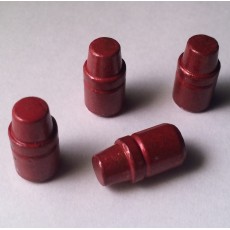I've been working up some loads in .38 S&W Special, using three bullets.
All are cast lead from Acme Bullet Company, 125 grain TC-RN, a coated 158 grain SWC and a Keith style 158 grain RN-FP. All sized .358
Going from my resources, I've been trying 6.3 grains of Hodgdon HS-6, with a magnum primer, in the 158 grain loads; 7.3 grains HS-6 in the 125 grain load.
Today, over the chronograph, I got the following averages.
125 grain TC-RN
M64 2"
838.0 fps avg
M15 4"
991.2 fps avg
M14 6"
979.5 fps avg
158 grain coated SWC
M64 2"
771.7
M15 4"
843.3
M14 6"
853.8
158 grain "Keith"
M64 2"
802.8
M15 4"
884.6
M14 6"
867.8
So, in the 125 grain and the "Keith" 158, my 4" M15 shot about 20 fps faster than my 6" M14. Now this could just be due to tolerance of these two particular revolvers, and I certainly could run some through many other 4 and 6 inchers, but as fun as that sounds I don't think I'm going to do that right this second. The coated 158 did go 10 fps faster out of the M14, so that may contradict the other findings.
My thought is *perhaps* the chosen powder charge is used up by about 4 inches and if I use more HS-6 or switch to something a little slower I may see increased gains from the longer barrel.
And that's my question, am I on the right track?
I am not looking to make any wrist-wrenching Keith loads, but I would like to get in the 950-975 fps range out of the M15 with the 158's, and a bit over 1000 in the M14.

I have an older version that has a round nose, not this flat one.
In fact, maybe it was a Lasercast slug, the lube was red, not blue.


All are cast lead from Acme Bullet Company, 125 grain TC-RN, a coated 158 grain SWC and a Keith style 158 grain RN-FP. All sized .358
Going from my resources, I've been trying 6.3 grains of Hodgdon HS-6, with a magnum primer, in the 158 grain loads; 7.3 grains HS-6 in the 125 grain load.
Today, over the chronograph, I got the following averages.
125 grain TC-RN
M64 2"
838.0 fps avg
M15 4"
991.2 fps avg
M14 6"
979.5 fps avg
158 grain coated SWC
M64 2"
771.7
M15 4"
843.3
M14 6"
853.8
158 grain "Keith"
M64 2"
802.8
M15 4"
884.6
M14 6"
867.8
So, in the 125 grain and the "Keith" 158, my 4" M15 shot about 20 fps faster than my 6" M14. Now this could just be due to tolerance of these two particular revolvers, and I certainly could run some through many other 4 and 6 inchers, but as fun as that sounds I don't think I'm going to do that right this second. The coated 158 did go 10 fps faster out of the M14, so that may contradict the other findings.
My thought is *perhaps* the chosen powder charge is used up by about 4 inches and if I use more HS-6 or switch to something a little slower I may see increased gains from the longer barrel.
And that's my question, am I on the right track?
I am not looking to make any wrist-wrenching Keith loads, but I would like to get in the 950-975 fps range out of the M15 with the 158's, and a bit over 1000 in the M14.

I have an older version that has a round nose, not this flat one.
In fact, maybe it was a Lasercast slug, the lube was red, not blue.


